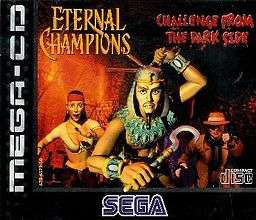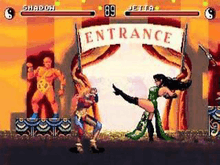Eternal Champions: Challenge from the Dark Side
Eternal Champions: Challenge from the Dark Side (also known as Eternal Champions 2 or Eternal Champions CD) is a fighting video game for the Sega CD/Mega-CD. It was published in February 1995 in North America and during the same year in Europe, within the waning days of the platform lifespan.
| Eternal Champions: Challenge From The Dark Side | |
|---|---|
 Cover art | |
| Developer(s) | Sega Interactive Development Division |
| Publisher(s) | Sega[lower-alpha 1] |
| Director(s) | Michael Terlecki |
| Producer(s) | Michael Latham John C. Brandstetter |
| Designer(s) | Michael Latham |
| Programmer(s) | John Kuwaye |
| Artist(s) | David C. Russ Albert Co Francis Co |
| Composer(s) | Tristan des Prés |
| Platform(s) | Sega CD |
| Release | |
| Genre(s) | Fighting game |
| Mode(s) | Single-player, Multiplayer |
The game is a semi-sequel to the Sega Genesis/Mega Drive game Eternal Champions and was part two of a proposed trilogy of games by Sega. Both games were developed by an internal team at Sega Interactive Development Division and designed by Michael Lantham, a developer with Sega of America from their early days.
Eternal Champions: Challenge from the Dark Side includes the nine playable fighters and non-playable boss from the first game, and adds 13 new playable characters (nine of which are hidden) and a new boss. Also, new moves called "Cinekills" were added, which are essentially fatality scenes rendered in full motion video.
Gameplay

Eternal Champions: Challenge from the Dark Side makes most special attacks use less of the special attack meter than in the previous game. There are also some special attacks that do not deplete the special attack meter. Combo attacks are also introduced, and jumping attacks can be linked to ground attacks and most normal attacks can be linked to other normal attacks. Mild "juggle" combos can also be executed by landing an additional hit on an already aerial opponent.
The game also includes three new types of finishing moves. The first is a second "Overkill" in each stage, called "Sudden Death", that can be activated when the victim still has a little life left. The other two, "Vendetta" and "Cinekill", can be performed on a dazed opponent that has 20% or less of their life in the final round only. Sudden Deaths and Vendettas are often exceptionally gory, and the original Overkills were made gorier to match. During Overkills (and Sudden Deaths), the winning fighter is carried off the stage in a flash of light the moment the fateful blow was made. The game retains the stage-specific finishing moves called Overkills from the first Eternal Champions, and added ones for the new stages. These are performed by defeating the player's opponent in a way that ensures that they fall upon a certain area of ground. If they land in the right spot, the life bars disappear and some element of the background kills them.
The Vendetta is performed by motion and button presses identical to those used in a Mortal Kombat Fatality. Each character (except the unlockable animal characters) has their own Vendetta and each is performed differently.
Cinekills are triggered when the dominant player has earned (through successful combo attacks) temporarily unlimited inner strength/energy, the victim's health is 20% or lower, and the victim is stunned. In a Cinekill, the Dark Champion appears on the field and kills the victim in a full motion video cutscene that supposedly mimics the victim's greatest fear. Certain characters have the ability to combo into this style of finishing move, such as Trident who has an elaborate re-dizzy combo that culminates in a Cinekill. Only the base characters can receive Cinekills, though any character can trigger one. This type of finish activates automatically.
Plot
Like the first game, Eternal Champions: Challenge from the Dark Side follows the story of the Eternal Champion, who felt the balance of the universe and time had been disturbed by the deaths of key individuals who had been destined to change the world for the greater good. To restore the balance, he held a great contest in which the winner would be granted the gift of new life, allowing them to fulfill their rightful destiny.
In this second chapter, it is revealed that the Eternal Champion has an evil counterpart: the Dark Champion. The Dark Champion appears and declares that he also will enter the contest and that he has hidden four more warriors, preventing the contest from truly being fulfilled. The contestants must not only achieve the aims of the Eternal Champion but also face the Dark Champion if they want their lives back.
Challenge from the Dark Side includes all nine playable characters from the first Eternal Champions. New fighters include Riptide, a pirate from 1566 A.D.; Ramses III; an Egyptian pharaoh from 151 B.C.; Raven Gindhar, a voodoo priestess from 1802 A.D.; and Dawson McShane, a gambler from 1849 A.D. The game features multiple secret fighters including the Eternal Champion and the Dark Champion, along with Thomas "Blast" Chavez, a Green Beret from 1955 A.D.; Chin Wo, an acupuncturist and healer from 1815 A.D.; and Thanatos, the former Greek God of Death from 1692 A.D. In addition, six hidden joke characters can be unlocked, consisting of five animals (Hooter the Owl, Yappy the Dog, Crispy the Chicken, Zuni the Monkey, and Slither the Rattlesnake) and a parody fighter known as the Senator.
Both Blast and Chin Wo were originally intended for inclusion in the first Eternal Champions video game for the Sega Genesis, but had to be omitted due to memory limitations with the cartridge.
Release
Eternal Champions: Challenge from the Dark Side was the first game to carry Sega's internal Deep Water warning icon label, which was employed by Sega of America for games featuring adult content.[1] In North America, the game earned an "M" (for Mature) rating from for its graphic violence and gore from the freshly-introduced IDSA system (later ESRB). In Europe, it earned both an 18+ ELSPA rating and a 15 BBFC rating.
Reception
GamePro gave the game a mixed review. They highly approved of the stage designs and said the rendered cinematics "offer a nice alternative to the full-motion, live-action video prevalent on Sega CDs." However, they criticized that the game has only minor enhancements over the original Genesis game, and concluded with a reference to the Sega CD's "Welcome to the next level" advertising slogan: "Instead of taking us to the next level, EC has merely taken us to a different part of the same one."[2] Electronic Gaming Monthly gave it a 6.125 out of 10, with Ed Semrad summarizing it as "simply a hodgepodge of fatalities strewn across a poor fighting game." The other three members of the EGM review panel concurred that Sega seemed to be trying to draw attention away from the loose controls, sluggish combat, inappropriate audio, and lack of improvement from the first Eternal Champions using flashy fatality sequences. Though some of them found the fatalities entertaining, they said they were not enough to give the game any sort of lasting appeal.[3]
Retro gaming website Racketboy included it among the games that "defined" the Sega CD, noting that "Even though the Sega CD was a commercial failure, Challenge from the Dark Side sold better in the U.S. than the Genesis versions of Street Fighter II."[4]
Next Generation reviewed the game, rating it four stars out of five, and stated that what Sega did was "take a good game, and use the inexpensive storage capacity of CD to add surprises until they build something people will be digging stuff out of for years. Very cool."[5]
References
- Joel Easley, "Gore sinks 'Eternal Champions'", Toledo Blade, August 17, 1995.
- "ProReview: Eternal Champions: Challenge from the Dark Side". GamePro. No. 83. IDG. August 1995. p. 56.
- "Review Crew: Eternal Champions". Electronic Gaming Monthly. No. 73. Sendai Publishing. August 1995. p. 36.
- "Games that Defined the Sega CD". Racketboy. August 9, 2006. Retrieved 12 February 2016.
- "Finals". Next Generation. No. 2. Imagine Media. February 1995. p. 99.
External links
- Released under the Deep Water brand name in North America.